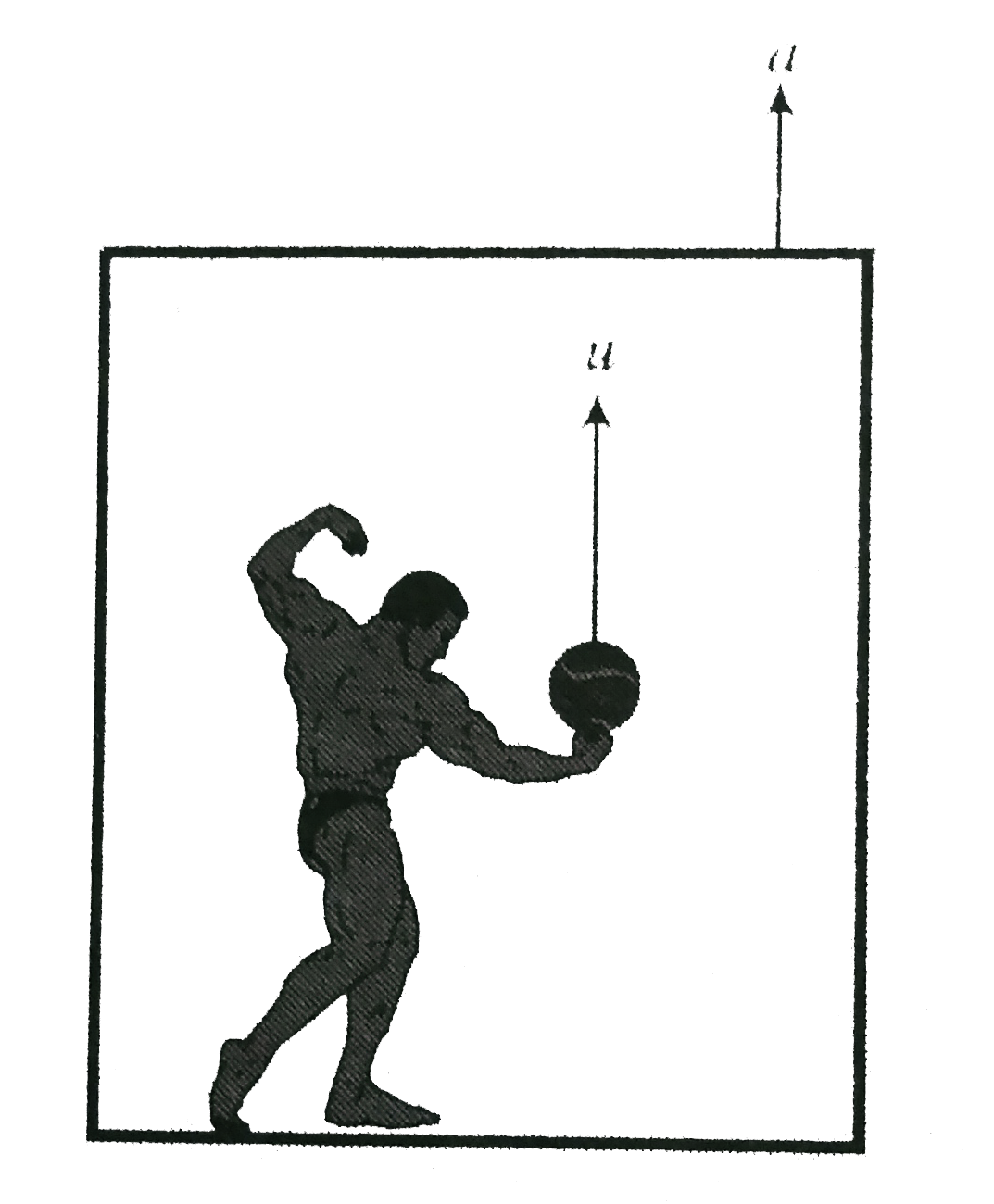A body is thrown up in a lift with a velocity 5ms−1 relative to the lift and the time of flight is found to be 0.8 s. The acceleration with which the lift is moving up is (g=10ms−2)
1.5ms−2
2ms−2
2.5ms−2
3ms−2
The correct Answer is:C
To solve the problem, we need to analyze the motion of a body thrown upwards from a lift that is also moving upwards with an unknown acceleration. We know the following:
- Relative velocity of the body with respect to the lift, u=5m/s
- Time of flight, t=0.8s
- Acceleration due to gravity, g=10m/s2
1. Understanding Relative Motion:
The body is thrown upwards with a velocity of 5m/s relative to the lift. If the lift is accelerating upwards with an acceleration a, the effective acceleration acting on the body when it is thrown upwards will be g+a (since both gravity and the lift's acceleration act in the same direction).
2. Using the Time of Flight:
The time of flight t is the total time the body is in the air before it returns to the same height from which it was thrown. The relative displacement during this time is zero because it returns to the initial position.
3. Applying the Equation of Motion:
The equation of motion for the body can be expressed as:
S=ut+12(−g−a)t2
Since the body returns to the same height, S=0:
0=5t−12(g+a)t2
4. Substituting Known Values:
Substitute t=0.8s and g=10m/s2:
0=5(0.8)−12(10+a)(0.82)
Simplifying gives:
0=4−12(10+a)(0.64)
0=4−(5+0.5a)(0.64)
5. Solving for a:
Rearranging the equation:
5+0.5a=40.64
5+0.5a=6.25
0.5a=6.25−5
0.5a=1.25
a=1.250.5=2.5m/s2
Final Answer:
The acceleration with which the lift is moving upwards is a=2.5m/s2.
- Time of flight, t=0.8s
- Acceleration due to gravity, g=10m/s2
The body is thrown upwards with a velocity of 5m/s relative to the lift. If the lift is accelerating upwards with an acceleration a, the effective acceleration acting on the body when it is thrown upwards will be g+a (since both gravity and the lift's acceleration act in the same direction).
The time of flight t is the total time the body is in the air before it returns to the same height from which it was thrown. The relative displacement during this time is zero because it returns to the initial position.
The equation of motion for the body can be expressed as:
S=ut+12(−g−a)t2
Since the body returns to the same height, S=0:
0=5t−12(g+a)t2
Substitute t=0.8s and g=10m/s2:
0=5(0.8)−12(10+a)(0.82)
Simplifying gives:
0=4−12(10+a)(0.64)
0=4−(5+0.5a)(0.64)
Rearranging the equation:
5+0.5a=40.64
5+0.5a=6.25
0.5a=6.25−5
0.5a=1.25
a=1.250.5=2.5m/s2
The acceleration with which the lift is moving upwards is a=2.5m/s2.
Topper's Solved these Questions
Similar Questions
A body is thrown up in a lift with a velocity u relative to the lift, and returns to the lift in time t. Show that the liftsupwardae≤rationis(2u-gt)/(t).
View SolutionA lift is moving up with acceleration a A person inside the ligt throws the ball upwards with a velocity u relativeto hand.
a. What is the time of flight of the ball?
b. What is the maximum height reached by the ball in the lift?
 View Solution
View Solution
Knowledge Check
- Question 1 - Select One
When a body is thrown up in a lift with a velocity u relative to the lift, the time of flight is found to be t. The acceleration with which the lift is moving up is
Au−gttBu+gttC2u−gttDut−2g - Question 2 - Select One
When a body is thrown up in a lift with a velocity u relative to the lift, the time of flight is found to be t. The acceleration with which the lift is moving up is
Au-gttBu+gttC2u-gttD2u+gtt - Question 3 - Select One
A body of mass 4 kg weighs 4.8 kg when suspended in a moving lift. The acceleration of the lift is
A9.80ms−2 downwardsB9.80ms−2 upwardsC1.96ms−1 downwardsD1.96ms−2 upwards
A body is thrown up with a velocity 100ms−1 it travels 5 m in the last swecond of upward journey if the same body thrown up with velocity 200ms−1, how much distance (in metre) will it travel in the last second of its upward journey (g=10ms−2)
View SolutionA coin is dropped in a lift. It takes time t1 to reach the floor when lift is stationary. It takes time t2 when lift is moving up with costant acceleration. Then
View SolutionA coin is dropped in a lift. It takes time t1 to reach the floor when lift is stationary. It takes time t2 when lift is moving up with constant acceleration. Then
View SolutionA ball thrown up vertically returns to the ground after 12.5 second. Find the velocity with which it was thrown up? (g=10ms−2)
View SolutionA particle is thrown up inside a stationary lift of sufficient height. The time of flight is T. Now it is thrown again with same initial speed v0 with respect to lift. At the time of second throw, lift is moving up with speed v0 and uniform acceleration g upward (the acceleration due to gravity). The new time of flight is:
View Solution

